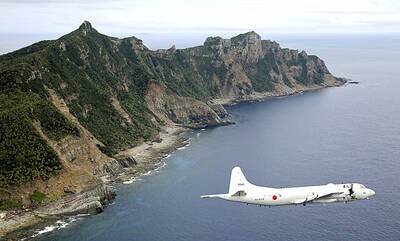A senior US defense official has accused China of changing the "status quo" in the Taiwan Strait by its missile buildup aimed at Taiwan, a situation that is forcing Washington to devise new ways to deal with the danger of a Chinese attack on Taiwan.
The official, Peter Rodman, the assistant secretary of defense for international security affairs, also pointed out that the US has developed improved defense relationships with a horseshoe-shaped ring of Asian nations around China that might come into play if China attacks Taiwan.
He made his comments in testimony at a hearing on China's military modernization conducted by the US Economic and Security Review Commission, a congressionally established investigative body, in Washington on Thursday.
While administration officials from US President George W. Bush down have long warned against unilateral changes to the "status quo" by either side of the Strait, this is believed to be the most direct assertion by a senior official in an open, official forum that China has unilaterally changed the "status quo."
In his testimony, Rodman ticked off a wide range of advanced weaponry that Beijing has acquired in recent years, much of it aimed at Taiwan, that has altered the military equation in the Strait, and has required new thinking by the US.
"Our will to meet our security commitments remain firm. This shows both that PLA [People's Liberation Army] modernization affects our strategic calculus for Taiwan Strait security and that a prudent hedging policy is essential," Rodman said.
"US policy opposes unilateral changes in the Taiwan Strait status quo by either party. The PLA military build-up changes that status quo and requires us to adapt to the new situation, as we are doing," Rodman said.
Afterwards, asked by reporters, Rodman pointed to the Chinese missile buildup across from Taiwan: "When you go from zero missiles opposite [Taiwan in] the Taiwan Strait, and a few years later there are 700, that's a change in the status quo."
When asked how the US is responding, Rodman said "Our job is to maintain a military balance in the region and we take our responsibility seriously."
"We have commitments to many friends and allies and obviously its our duty to make sure we're in a position to carry out those commitments," he added.
Rodman declined to be specific on revisions in US strategy to deal with the situation.
"It's a continuing process. It's our duty to be prepared for possible situations. I don't see this as an issue of alarm, it's an issue of prudence and what one would expect us to be doing," he said.
In response to a question at the hearing by a commission member to explain US "hedging policy," Rodman said, "it means being realistic about the risks of a Taiwan contingency and being prepared for that. It means keeping an eye on what they're doing and being ready to deal with it if the worst case should happen."
Rodman then added, "It means collaborating with allies." He said that over the past several years "our defense relations with a number of other countries in the region have improved, because other countries have the same reaction we do to China's rise."
In pointing to specific Chinese weapons acquisitions, Rodman mentioned Beijing's acquisition of five modern submarines, 10 new varieties of ballistic missiles with enhanced targeting capabilities, anti-ship cruise missiles and expeditionary warfare, including amphibious lift acquisitions.
also see story:
Cross-strait clash means `everybody loses,' US warns

MISINFORMATION: The generated content tends to adopt China’s official stance, such as ‘Taiwan is currently governed by the Chinese central government,’ the NSB said Five China-developed artificial intelligence (AI) language models exhibit cybersecurity risks and content biases, an inspection conducted by the National Security Bureau (NSB) showed. The five AI tools are: DeepSeek, Doubao (豆包), Yiyan (文心一言), Tongyi (通義千問) and Yuanbao (騰訊元寶), the bureau said, advising people to remain vigilant to protect personal data privacy and corporate business secrets. The NSB said it, in accordance with the National Intelligence Services Act (國家情報工作法), has reviewed international cybersecurity reports and intelligence, and coordinated with the Ministry of Justice Investigation Bureau and the National Police Agency’s Criminal Investigation Bureau to conduct an inspection of China-made AI language

BOOST IN CONFIDENCE: The sale sends a clear message of support for Taiwan and dispels rumors that US President Donald Trump ‘sold out’ the nation, an expert said The US government on Thursday announced a possible sale to Taiwan of fighter jet parts, which was estimated to cost about US$330 million, in a move that an expert said “sends a clear message of support for Taiwan” amid fears that Washington might be wavering in its attitude toward Taipei. It was the first announcement of an arms sale to Taiwan since US President Donald Trump returned to the White House earlier this year. The proposed package includes non-standard components, spare and repair parts, consumables and accessories, as well repair and return support for the F-16, C-130 and Indigenous Defense Fighter aircraft,

CHECKING BOUNDARIES: China wants to disrupt solidarity among democracies and test their red lines, but it is instead pushing nations to become more united, an expert said The US Department of State on Friday expressed deep concern over a Chinese public security agency’s investigation into Legislator Puma Shen (沈伯洋) for “secession.” “China’s actions threaten free speech and erode norms that have underpinned the cross-strait ‘status quo’ for decades,” a US Department of State spokesperson said. The Chongqing Municipal Public Security Bureau late last month listed Shen as “wanted” and launched an investigation into alleged “secession-related” criminal activities, including his founding of the Kuma Academy, a civil defense organization that prepares people for an invasion by China. The spokesperson said that the US was “deeply concerned” about the bureau investigating Shen

DISPUTE: A Chinese official prompted a formal protest from Tokyo by saying that ‘the dirty head that sticks itself out must be cut off,’ after Takaichi’s Taiwan remarks Four armed China Coast Guard vessels yesterday morning sailed through disputed waters controlled by Japan, amid a diplomatic spat following Japanese Prime Minister Sanae Takaichi’s comments on Taiwan. The four ships sailed around the Senkaku Islands — known as the Diaoyutai Islands (釣魚台) to Taiwan, and which Taiwan and China also claim — on Saturday before entering Japanese waters yesterday and left, the Japan Coast Guard said. The China Coast Guard said in a statement that it carried out a “rights enforcement patrol” through the waters and that it was a lawful operation. As of the end of last month,